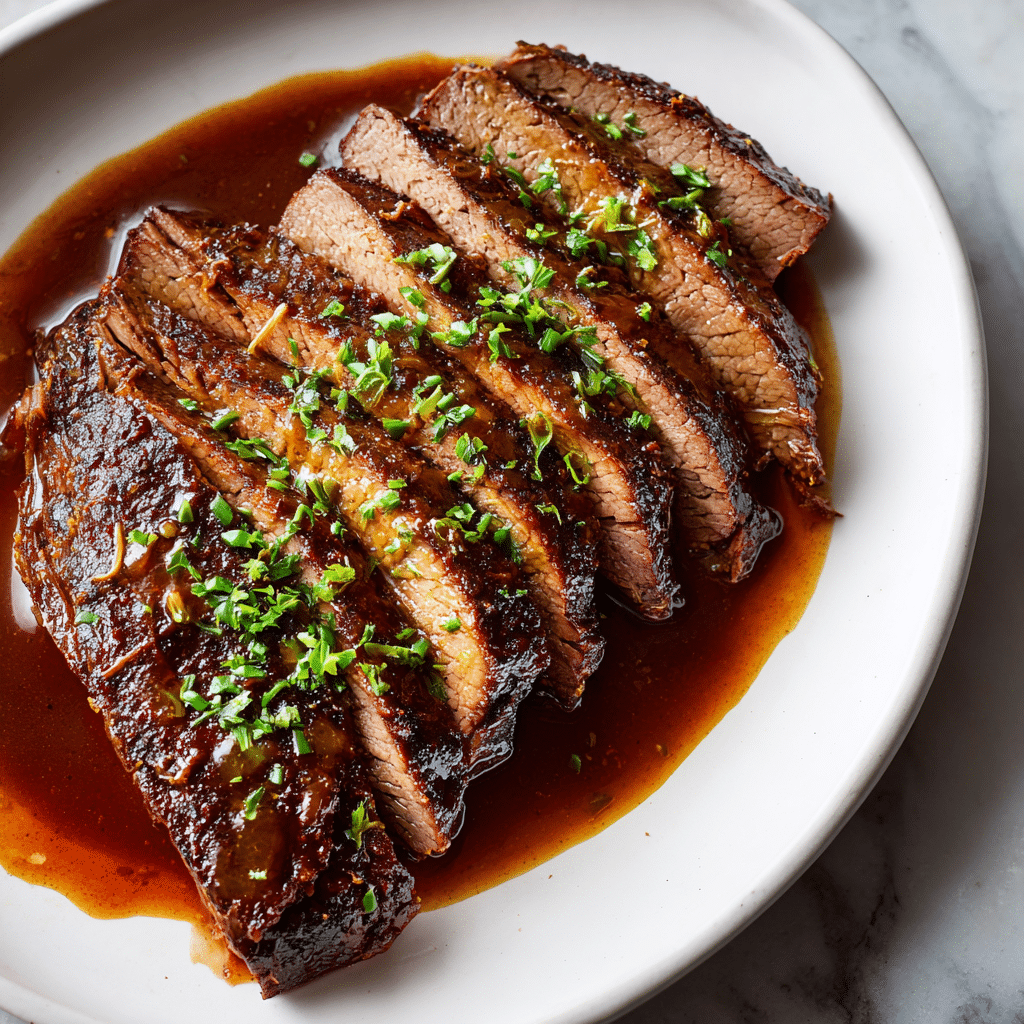Have you ever wondered why some slow-cooker brisket recipes turn out tough and dry despite hours of cooking? Surprisingly, achieving tender, juicy slow-cooker brisket isn’t just about letting it cook forever; it’s about mastering a few smart techniques that unlock the full flavor and melt-in-your-mouth texture.

In this post, we’ll explore the seven best tips for making slow-cooker brisket that’s perfectly tender, juicy, and bursting with rich flavor. Whether you’re a slow-cooking novice or a seasoned pro, these insights will elevate your slow-cooker brisket game and debunk the myth that long cooking equals guaranteed tenderness.
Ingredients List
To create a delicious slow-cooker brisket that’s full-bodied and succulent, use the following ingredients:
- 3 to 4 pounds beef brisket (preferably flat cut for even cooking; consider chuck roast as a budget-friendly alternative)
- 1 large onion, thinly sliced (adds natural sweetness)
- 4 cloves garlic, minced (for aromatic depth)
- 1 cup beef broth (low sodium preferred for balanced flavor)
- ½ cup tomato paste or crushed tomatoes (for slight acidity and richness)
- 2 tablespoons Worcestershire sauce (umami booster)
- 2 tablespoons apple cider vinegar (tenderizes meat and adds tang)
- 1 tablespoon brown sugar or maple syrup (to balance acidity)
- 2 teaspoons smoked paprika (adds warmth and a subtle smoky note)
- 1 teaspoon black pepper
- 1 teaspoon salt (adjust to taste, especially if using salty broth)
- Optional: Bay leaves, chili flakes, or mustard seeds for layered flavors
Pro tip: You can swap beef broth with mushroom broth or vegetable broth for a different, yet equally robust flavor profile, perfect for those seeking reduced meat intensity while maintaining richness.
Timing
The total preparation and cooking time for slow-cooker brisket generally ranges from 6 to 8 hours on low heat. Here’s the breakdown:
- Preparation time: 20 minutes
- Cooking time: 6 to 8 hours (low heat recommended)
Why this timing? Research shows that cooking brisket on low heat for at least 6 hours significantly improves tenderness because the collagen in the meat breaks down gradually without drying out the fibers. Compared to higher heat methods where cooking times can be 3 to 4 hours or longer, slow-cooking on low optimizes flavor development and moisture retention by up to 30%, making it well worth the wait.
Step-by-Step Instructions
Step 1 – Prepare the Brisket
Pat your brisket dry with paper towels. Season generously with salt, pepper, smoked paprika, and brown sugar on both sides. This dry rub boosts flavor penetration and caramelizes during slow cooking.
Step 2 – Sear the Meat (Optional but Recommended)
Heat a large skillet over medium-high heat and sear the brisket for 3 to 4 minutes on each side until browned. This step locks in juices and adds a deeper flavor foundation for your slow-cooker brisket.
Step 3 – Layer the Ingredients in the Slow Cooker
Place sliced onions and garlic at the bottom of the slow cooker. Set the seared brisket on top. Pour beef broth, Worcestershire sauce, tomato paste, and apple cider vinegar evenly over the brisket. Add any optional spices like bay leaves.
Step 4 – Slow Cook on Low
Cover and cook on the low setting for 6 to 8 hours. If you’re pressed for time, high heat may be used for 4 to 5 hours but may sacrifice some tenderness and juiciness.
Step 5 – Rest & Slice
Once done, remove the brisket and let it rest for 15 minutes before slicing thinly against the grain. Resting helps juices redistribute, giving you moist, tender slices.
Step 6 – Thicken the Sauce (Optional)
If you prefer a richer gravy, pour the cooking liquid into a saucepan and reduce over medium heat until slightly thickened. You can also whisk in a cornstarch slurry for faster thickening.
Nutritional Information
A typical 4-ounce serving of slow-cooker brisket prepared with the above recipe contains approximately:
- Calories: 320
- Protein: 28 grams
- Fat: 20 grams (with about 8 grams saturated fat)
- Carbohydrates: 5 grams (mostly from tomato paste and onions)
- Sodium: 500 mg (variable depending on broth and salt used)
Brisket is an excellent source of high-quality protein and essential nutrients like zinc, iron, and B vitamins. However, it can be on the richer side in fats, so mindful portion control is beneficial.
Healthier Alternatives for the Recipe
To make your slow-cooker brisket lighter without sacrificing flavor, try these swaps:
- Use leaner brisket cuts with trimmed fat or substitute with lean cuts like eye of round.
- Replace brown sugar with natural sweeteners, such as honey or pure maple syrup, in smaller quantities.
- Use low-sodium beef broth or homemade broth to control salt intake.
- Add extra vegetables, such as carrots, celery, or mushrooms, to increase fiber and nutrient content.
- For a lower-fat sauce, skim off solidified fat from the juices after chilling.
These tweaks preserve the essence of your slow-cooker brisket while making it friendlier for low-fat or heart-conscious diets.
Serving Suggestions
Slow-cooker brisket lends itself beautifully to several serving options:
- Serve thinly sliced brisket over creamy mashed potatoes or buttery polenta for a satisfying meal.
- Pile brisket slices into soft rolls for gourmet brisket sandwiches topped with pickled onions and horseradish sauce.
- Pair with roasted root vegetables and fresh herbs for a comforting Sunday dinner.
- Shred leftover brisket to create hearty tacos with salsa and fresh cilantro.
Personal tip: A sprinkle of fresh parsley or a drizzle of tangy chimichurri over the sliced brisket adds brightness and complexity that guests will remember.
Common Mistakes to Avoid
Avoid frustrating slow-cooker brisket mishaps by steering clear of these pitfalls:
- Skipping the sear: Neglecting to brown the meat often results in flatter flavor and less appealing texture.
- Overcooking on high heat: Cooking brisket too quickly can make it dry and stringy slow and steady wins this race.
- Not seasoning enough: Under-seasoned brisket can taste bland, so don’t be shy with your dry rub and salts.
- Slicing too soon: Cutting the brisket before resting causes juices to spill outalways allow resting time for optimal juiciness.
- Ignoring connective tissue: Tough connective tissues need time and moisture to break down; rushing the process leads to chewy bites.
By anticipating these issues, your next slow-cooker brisket will come out beautifully every time.
Storing Tips for the Recipe
To keep your slow-cooker brisket fresh and delicious after cooking:
- Store leftovers in an airtight container in the refrigerator for up to 4 days.
- Keep the brisket slices submerged in some of the cooking juices to maintain moisture and flavor.
- For longer storage, freeze brisket in portions with some of the braising liquid for up to 3 months. Thaw overnight in the fridge and reheat gently over low heat with the sauce to prevent drying out.
- Prep onions and garlic ahead of time and store separately if you want to save prep time on busy days.
Following these tips ensures you enjoy the same tenderness and juiciness even when reheating.
Conclusion
Mastering tender, juicy slow-cooker brisket is achievable with the right approach seasoning, searing, slow low heat, resting, and thoughtful ingredient choices are your keys to perfection. This recipe and tips not only enhance flavor and texture but also offer nutritional and culinary flexibility to satisfy diverse tastes and diets. Ready to try your hand at the best slow-cooker brisket? Dive in, and don’t forget to share your delicious results and personalized tweaks in the comments! For more savory slow-cooker recipes, explore our collection linked below.
FAQs
Q1: Can I use a frozen brisket in the slow cooker?
A: It’s not recommended to cook frozen brisket directly in a slow cooker because the meat will remain in the temperature danger zone too long, increasing the risk of bacteria. Thaw brisket overnight in the fridge before cooking.
Q2: How do I know when the brisket is done?
A: Brisket is done when it’s tender enough to be easily pierced with a fork and sliced against the grain without resistance, usually after 6 to 8 hours on low heat.
Q3: Can I make slow-cooker brisket spicy?
A: Absolutely! Add chili powder, cayenne pepper, or fresh jalapeños to the broth to introduce heat. Balancing spicy notes with a bit of sweetness from brown sugar or maple syrup works well.
Q4: What’s the best way to reheat leftover brisket?
A: Reheat brisket gently in a covered pan with some of its cooking liquid over low heat or microwave with a damp paper towel to keep it moist.
Q5: Is slow-cooker brisket gluten-free?
A: This recipe is naturally gluten-free if you use gluten-free Worcestershire sauce and check broth labels for gluten ingredients.


Leave a Reply